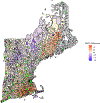Estimating a Causal Exposure Response Function with a Continuous Error-Prone Exposure: A Study of Fine Particulate Matter and All-Cause Mortality
- PMID: 37063643
- PMCID: PMC10103900
- DOI: 10.1007/s13253-022-00508-z
Estimating a Causal Exposure Response Function with a Continuous Error-Prone Exposure: A Study of Fine Particulate Matter and All-Cause Mortality
Abstract
Numerous studies have examined the associations between long-term exposure to fine particulate matter (PM2.5) and adverse health outcomes. Recently, many of these studies have begun to employ high-resolution predicted PM2.5 concentrations, which are subject to measurement error. Previous approaches for exposure measurement error correction have either been applied in non-causal settings or have only considered a categorical exposure. Moreover, most procedures have failed to account for uncertainty induced by error correction when fitting an exposure-response function (ERF). To remedy these deficiencies, we develop a multiple imputation framework that combines regression calibration and Bayesian techniques to estimate a causal ERF. We demonstrate how the output of the measurement error correction steps can be seamlessly integrated into a Bayesian additive regression trees (BART) estimator of the causal ERF. We also demonstrate how locally-weighted smoothing of the posterior samples from BART can be used to create a more accurate ERF estimate. Our proposed approach also properly propagates the exposure measurement error uncertainty to yield accurate standard error estimates. We assess the robustness of our proposed approach in an extensive simulation study. We then apply our methodology to estimate the effects of PM2.5 on all-cause mortality among Medicare enrollees in New England from 2000-2012.
Figures




Similar articles
-
Assessing Adverse Health Effects of Long-Term Exposure to Low Levels of Ambient Air Pollution: Implementation of Causal Inference Methods.Res Rep Health Eff Inst. 2022 Jan;2022(211):1-56. Res Rep Health Eff Inst. 2022. PMID: 36193708 Free PMC article. Review.
-
Measurement error correction for ambient PM2.5 exposure using stratified regression calibration: Effects on all-cause mortality.Environ Res. 2023 Jan 1;216(Pt 4):114792. doi: 10.1016/j.envres.2022.114792. Epub 2022 Nov 11. Environ Res. 2023. PMID: 36375508 Free PMC article.
-
CAUSAL INFERENCE IN THE CONTEXT OF AN ERROR PRONE EXPOSURE: AIR POLLUTION AND MORTALITY.Ann Appl Stat. 2019 Mar;13(1):520-547. doi: 10.1214/18-AOAS1206. Epub 2019 Apr 10. Ann Appl Stat. 2019. PMID: 31649797 Free PMC article.
-
The association of long-term exposure to PM2.5 on all-cause mortality in the Nurses' Health Study and the impact of measurement-error correction.Environ Health. 2015 May 1;14:38. doi: 10.1186/s12940-015-0027-6. Environ Health. 2015. PMID: 25926123 Free PMC article.
-
Mortality and Morbidity Effects of Long-Term Exposure to Low-Level PM2.5, BC, NO2, and O3: An Analysis of European Cohorts in the ELAPSE Project.Res Rep Health Eff Inst. 2021 Sep;2021(208):1-127. Res Rep Health Eff Inst. 2021. PMID: 36106702 Free PMC article.
Cited by
-
Time-lagged relationships between a decade of air pollution exposure and first hospitalization with Alzheimer's disease and related dementias.Environ Int. 2023 Jan;171:107694. doi: 10.1016/j.envint.2022.107694. Epub 2022 Dec 12. Environ Int. 2023. PMID: 36521347 Free PMC article.
-
Policy-induced air pollution health disparities: Statistical and data science considerations.Science. 2024 Jul 26;385(6707):391-396. doi: 10.1126/science.adp1870. Epub 2024 Jul 25. Science. 2024. PMID: 39052789 Free PMC article. Review.
-
Addressing confounding and continuous exposure measurement error using corrected score functions.Biometrics. 2025 Apr 2;81(2):ujaf045. doi: 10.1093/biomtc/ujaf045. Biometrics. 2025. PMID: 40297938
-
Mortality risk from United States coal electricity generation.Science. 2023 Nov 24;382(6673):941-946. doi: 10.1126/science.adf4915. Epub 2023 Nov 23. Science. 2023. PMID: 37995235 Free PMC article.
-
Air Pollution and Cardiovascular and Thromboembolic Events in Older Adults With High-Risk Conditions.Am J Epidemiol. 2023 Aug 4;192(8):1358-1370. doi: 10.1093/aje/kwad089. Am J Epidemiol. 2023. PMID: 37070398 Free PMC article.
References
-
- Anderson HR (2009). Air pollution and mortality: A history. Atmospheric Environment, 43(1):142–152.
-
- Bateson TF and Wright JM (2010). Regression calibration for classical exposure measurement error in environmental epidemiology studies using multiple local surrogate exposures. American journal of epidemiology, 172(3):344–352. - PubMed
-
- Brook RD, Rajagopalan S, Pope CA III, Brook JR, Bhatnagar A, Diez-Roux AV, Holguin F, Hong Y, Luepker RV, Mittleman MA, et al. (2010). Particulate matter air pollution and cardiovascular disease: an update to the scientific statement from the american heart association. Circulation, 121(21):2331–2378. - PubMed
Grants and funding
LinkOut - more resources
Full Text Sources
